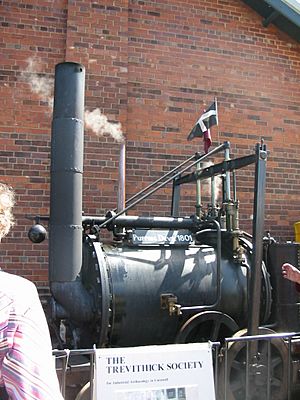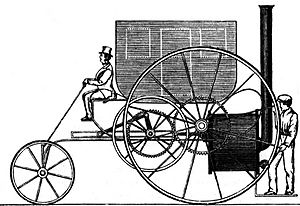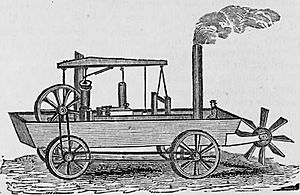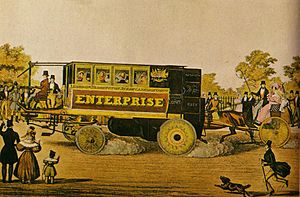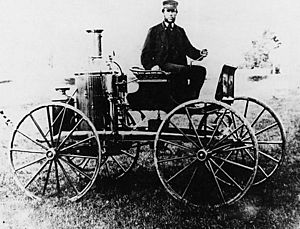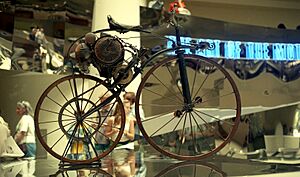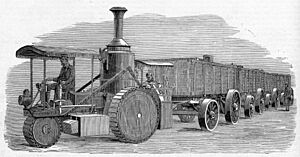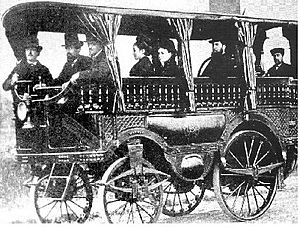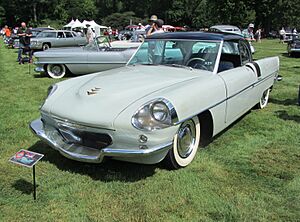History of steam road vehicles facts for kids
Have you ever wondered how people traveled before gasoline cars? Long ago, some amazing vehicles ran on steam! The history of steam road vehicles is all about how cars, trucks, and other machines that moved on roads were powered by steam engines. These weren't trains on tracks, but vehicles for regular roads, like early steam cars and trucks, or big machines for farms and carrying heavy loads.
The very first experimental steam vehicles were built in the 1700s and 1800s. But it wasn't until around 1800, when Richard Trevithick figured out how to use high-pressure steam, that these vehicles became truly practical. By the 1850s, steam road vehicles were good enough to be sold to people. However, laws soon made it hard or even illegal to use them on roads.
Even with these challenges, steam vehicle technology kept getting better from the 1880s to the 1920s. Steam road vehicles were used for many different jobs. But in the 1900s, gasoline engines improved very quickly. This led to the end of steam engines for most vehicles. Very few steam vehicles were still used after World War II.
Today, many old steam vehicles are kept by people who love them. You can still see them working at special events! In the 1960s, there was a short time when people thought steam cars might help with air pollution. But besides enthusiasts and a few experiments, new steam vehicles are not made anymore.
Early steam vehicles had some big downsides. They took a long time to start because water had to boil to make steam. They burned coal, which was dirty and made a lot of smoke. Fuel was bulky and messy to load. Hot ash also had to be removed. Plus, they needed a lot of water. Most had metal wheels, which meant less grip on the road. They were also very heavy. Owners often had to do their own repairs. Their top speed was only about 20 miles per hour, and they were slow to speed up.
Over time, steam vehicle technology got better. Later models used cleaner liquid fuel like kerosene. They had rubber tires and special parts called condensers to reuse water. They also became lighter. But even with these improvements, they couldn't keep up with the fast-growing gasoline engine. Gasoline cars became the main type of vehicle for the rest of the 20th century.
Contents
- Who Were the First Steam Car Builders?
- Steam Bus Services Begin
- Steam Vehicles in the Military
- The Victorian Age of Steam Cars
- Rickett's Steam Car
- Roper's Steam Car
- Manzetti's Steam Car
- Holt's Road Steamer
- Taylor's Steam Buggy
- Michaux-Perreaux Steam Velocipede
- Knight's Steam Carriage
- Catley and Ayres Steam Car
- Thomson's Road Steamer
- Kemna's Road Steamer
- Randolph's Steam Bus
- Bollée's Steam Bus
- Grenville's Steam Car
- Cederholm's Steam Car
- Shearer's Steam Car
- De Dion & Bouton Steam Vehicles
- Locomobile Company of America
- Stanley Motor Carriage Company
- Steam Cars in the 1900s
- Steam Cars in the Late 1900s
- Images for kids
- See also
Who Were the First Steam Car Builders?

Before 1700, people were already trying to make self-moving machines using steam. The first useful steam engines were very large and stayed in one place. To make them small enough for roads, engineers had to use higher steam pressure. This was dangerous because boilers weren't very safe back then. James Watt, a famous inventor, was against high-pressure steam. He tried to stop William Murdoch from building his steam carriage model in 1784. Murdoch later built a bigger one in 1791 but had to stop working on it.
In the late 1700s, many people tried to build self-driving vehicles. But they faced many problems. Roads were bad, and it was hard to make an engine that could turn wheels smoothly. Tires, strong bodies, brakes, suspension, and steering were all big challenges. These difficulties, along with strict laws, slowed down progress for over a hundred years.
Verbiest's Steam Carriage
Some people believe Ferdinand Verbiest built the first steam carriage around 1679. Not much is known about it. It was a small model, not meant to carry a driver or goods. This Belgian vehicle might have inspired later steam carriages in Italy and France.
Cugnot's "Steam Wagon"
Nicolas-Joseph Cugnot built his "fire engine for transporting wagons and especially artillery" in two versions, one in 1769 and another in 1771. These were for the French Army. This was the first known full-size steam wagon, not just a toy. Cugnot's fardier (a word for a heavy two-wheeled cart) was designed to carry 4 tonnes (about 8,800 pounds) and travel up to 4 km/h (2.5 mph). It had three wheels: two at the back and one steerable front wheel. There is good evidence that this vehicle actually ran, making it possibly the first to do so. However, it was unstable and didn't meet the army's needs, so it was a short experiment.
Early British Steam Cars
In 1786, William Symington built a steam carriage. A British patent for a steam car was given to Fourness and Ashworth in December 1788.
Trevithick's Steam Carriages
In 1801, Richard Trevithick built an experimental steam vehicle called Puffing Devil. It had a special firebox inside the boiler and one vertical cylinder. The engine directly powered the wheels. It weighed about 1,520 kg (3,350 pounds) when loaded and could go 14.5 km/h (9 mph) on flat ground. On its first trip, it was left alone and broke down. Trevithick soon built the London Steam Carriage, which ran well in London in 1803. But people weren't interested, and the project soon ended.
Evans' Amphibious Steam Vehicle
In 1805, Oliver Evans built the Oruktor amphibolos (meaning "Amphibious digger"). This was a steam-powered dredger (a machine for digging underwater) that he made able to move on both water and land. It's thought to be the first amphibious vehicle and the first steam-powered road vehicle in the United States. However, no designs exist, and only Evans's own stories describe its achievements. Some experts think its 5 horsepower engine wasn't strong enough to move it on land or water. They believe gravity, river currents, and tides helped it move during its demonstrations. The dredger wasn't successful and was later taken apart for parts.
Summers and Ogle Steam Carriage
Around 1830 or 1831, Summers and Ogle, a company in Southampton, made two three-wheeled steam carriages. In 1831, Nathaniel Ogle from the company spoke to a special committee about steam carriages. In 1832, one of their steam carriages traveled to Birmingham and Liverpool. A newspaper in June 1833 described a trip in London:
On Saturday last Mr Nathaniel Ogle, accompanied by several ladies, together with Mr G Burdett, Mr Macgary, Mr C Bischoff, Mr Babbage and other gentlemen, proceeded by his steam carriage from the Bazaar in King street, Portman square to call on Mr Rothschild at his residence at Stamford hill. The vehicle, although it has been rattled over the roads nearly six hundred miles, is in efficient condition. A small quantity of waste steam was perceptible at first, until the boilers and casing were hot. The distance, full seven miles, was cleared, not withstanding the crowded state of the roads, in thirty one minutes, and the sudden and narrow ascent to Mr Rothschild's made with perfect precision, which was hardly to be expected from so long and ponderous a vehicle. The party was most urbanely and kindly received by Mrs and Mr Rothschild, and after having partaken of refreshments returned to Baker street.
Steam Bus Services Begin
For a while, steam carriage services were more successful than Trevithick's car. These services ran in England in the 1830s, mainly by people working with Sir Goldsworthy Gurney and Walter Hancock. In Scotland, John Scott Russell also ran services. However, high road tolls (fees to use roads) made steam road vehicles less popular. This allowed horse-drawn transport to remain dominant until railways became common in the 1840s and 1850s.
Sir James C. Anderson and Jasper Wheeler Rogers were the first to bring steam vehicles to Ireland. They built their own versions in the 1830s and 1840s. They wanted a country-wide transport system using Ireland's mail coach roads. A newspaper article from 1838 said Anderson and his father spent "a fortune in building twenty-nine unsuccessful carriages to succeed in the thirtieth." Jasper Rogers built his Irish steam cars in a former factory in Dublin.
Rogers and Anderson believed their steam vehicle system would create more jobs than railways. They thought railways would reduce the need for workers. Their system needed many stations for fuel and water. These stations could also have "road police" and telegraph offices. This way, even small Irish villages could be part of the network. Locals could earn money by bringing rocks for road repairs. Every village would also need a road repair crew.
Steam Vehicles in the Military
During the Crimean War (1853–1856), a traction engine was used to pull many open trucks. In the 1870s, many armies tried using steam tractors to pull long lines of supply wagons. By 1898, steam traction engine trains with up to four wagons were used in military exercises in England. In 1900, John Fowler & Co. made armored road trains for the British forces in the Second Boer War.
The Victorian Age of Steam Cars
Even though engineers created clever steam-powered road vehicles, they weren't as widely accepted as steamships or trains in the mid-to-late 1800s.
Ransomes built a portable steam engine for farms in 1841. It was pulled by horses. The next year, Ransomes made it so the engine could drive itself to farms.
Strict laws almost completely removed steam vehicles from British roads for 30 years. The Locomotive Act 1861 set very slow speed limits: 5 mph (8 km/h) in towns and 10 mph (16 km/h) in the countryside. The Locomotives Act 1865, famous as the Red Flag Act, made limits even slower: 4 mph (6.4 km/h) in the country and just 2 mph (3.2 km/h) in towns. This law also required a person to walk in front of every vehicle, carrying a red flag (or a red lantern at night). Local authorities could also decide when these vehicles could use the roads. The only exceptions were street trams, which got special permission from 1879.
In France, things were different. A rule in 1861 officially allowed steam vehicles on regular roads. This led to many new inventions in the 1870s and 1880s. However, steam vehicles were still rare.
The success of railways also reduced the need for steam road vehicles. From the 1860s, people focused more on traction engines. These could be used for farm work like sawing wood or for moving very large loads that couldn't go by train. Steam trucks were also developed, but they were mostly used for local delivery of heavy items like coal and building materials from train stations and ports.
Rickett's Steam Car
In 1854, Thomas Rickett built his first steam car. In 1858, he built a second one. It looked more like a small train engine than a car. It had a steam engine on three wheels: two large driving wheels at the back and one smaller steering wheel at the front. The machine weighed 1.5 tonnes (about 3,300 pounds). It was driven by a chain drive and could reach a top speed of 12 miles per hour (19 km/h).
Two years later, in 1860, Rickett built a similar but heavier vehicle. This one used spur-gears instead of a chain. His final design looked like a railway locomotive, with the engine's cylinders directly connected to the driving axle.
Roper's Steam Car
Sylvester H. Roper drove a steam car he invented around Boston, Massachusetts, in 1863. One of his 1863 steam cars is now in the Henry Ford Museum. In 1972, it was the oldest car in their collection. Around 1867–1869, he built a steam velocipede, which might have been the first motorcycle. Roper died in 1896 from heart failure while testing a newer version of his steam motorcycle.
Manzetti's Steam Car
In 1864, Italian inventor Innocenzo Manzetti built a road steamer. It had the boiler at the front and a single cylinder engine.
Holt's Road Steamer
H.P. Holt built a small road steamer in 1866. It could go 20 miles per hour (32 km/h) on flat roads. It had a vertical boiler at the back and two separate twin-cylinder engines. Each engine drove one rear wheel using a chain and sprockets.
Taylor's Steam Buggy
In 1867, Canadian jeweler Henry Seth Taylor showed his four-wheeled steam buggy at a fair in Stanstead, Quebec. He showed it again the next year. He started building the buggy in 1865. It was based on a high-wheeled carriage with extra support for a two-cylinder steam engine placed on the floor.
Michaux-Perreaux Steam Velocipede
Around 1867–1869 in France, a Louis-Guillaume Perreaux steam engine was attached to a Pierre Michaux bicycle frame. This created the Michaux-Perreaux steam velocipede. Along with the Roper steam velocipede, it might have been the first motorcycle. The only Michaux-Perreaux Steam velocipede ever made is now in a museum in Sceaux, France.
Knight's Steam Carriage
From 1868 to 1870, John Henry Knight built a four-wheeled steam carriage. It first had only a single-cylinder engine.
Catley and Ayres Steam Car
In 1869, a small three-wheeled vehicle was made. It was powered by a horizontal twin-cylinder engine that drove the rear axle. Only one rear wheel was powered; the other spun freely. A vertical boiler was at the back, covered in polished copper. The boiler was inside a mahogany case. The vehicle weighed only 19 cwt (about 2,100 pounds), and the front wheel was used for steering.
Thomson's Road Steamer
In 1869, the road steamer built by Robert William Thomson became famous because its wheels had thick, solid rubber tires. Thomson's first road steamers, made in his workshop in Leith, had three wheels. The small front wheel was directly under the steering wheel. The tires were 125 mm (5 inches) thick and stuck to the wheel by friction. He then had T. M. Tennant and Co make them. But they couldn't keep up with demand, so in 1870, some production moved to Robey & Co in Lincoln.
Over the next two years, Robeys built 32 of these vehicles, either 8 or 12 horsepower versions. Many were sent to other countries, including Italy, Austria, Turkey, Australia, New Zealand, India, Ireland, Chile, Russia, and Greece. Another Thomson steam vehicle was built in 1877. After that, Robeys stopped making road steam vehicles until 1904, when they started making steam road lorries.
Kemna's Road Steamer
In 1871, Julius Kemna, a German businessman, started selling English steam threshing machines. A few years later, Kemna began making other steam-powered vehicles like road rollers, and high-quality steam ploughing engines and road steamers.
Randolph's Steam Bus
In 1872, a steam coach by Charles Randolph of Glasgow weighed 4.5 tons (about 9,000 pounds) and was 15 feet (4.6 meters) long. But it could only go 6 mph (9.7 km/h). It had two vertical twin-cylinder engines that worked separately. Each engine drove one of the rear wheels. The whole vehicle was enclosed with windows all around. It could carry six people and even had two driving mirrors to see traffic behind it. This is the earliest known use of such mirrors!
Bollée's Steam Bus
From 1873 to 1883, Amédée Bollée built a series of steam-powered passenger vehicles. They could carry 6 to 12 people at speeds up to 60 km/h (37 mph). Some names were La Rapide and L'Obéissante. In L'Obeissante, the boiler was behind the passenger area, and the engine was at the front. It drove the rear wheels using a shaft and chain. The driver sat behind the engine and steered with a wheel. Its design was much more like later gasoline cars than other steam vehicles. Also, in 1873, it had independent suspension on all four wheels.
Grenville's Steam Car
From 1875 to 1880, R. Neville Grenville built a three-wheeled steam vehicle. It could travel up to 15 mph (24 km/h). This vehicle still exists today! It was kept at the Bristol Museum & Art Gallery for many years and is now at the National Motor Museum, Beaulieu.
Cederholm's Steam Car
In 1892, painter Joens Cederholm and his brother André, a blacksmith, designed their first car. It was a two-seater and had a condenser (a part that reuses water) added in 1894. It wasn't very successful.
Shearer's Steam Car
Starting in 1894, David Shearer designed and built the first car in Australia. It could go 15 mph (24 km/h) on the streets of Adelaide. The boiler was his own design. Steering was done with a tiller (a bar). A photo shows it carrying eight passengers. The car's first official road test was in 1899.
De Dion & Bouton Steam Vehicles
The invention of the flash steam boiler by Léon Serpollet led to small steam tricycles and quadricycles in the late 1880s and early 1890s. De Dion and Bouton made notable ones. These vehicles did well in long-distance races. But soon, they faced tough competition from gasoline cars, especially those made by Peugeot. Gasoline cars quickly took over most of the market. Steam car supporters had a long battle to keep steam cars going, a battle that continued into modern times.
Locomobile Company of America
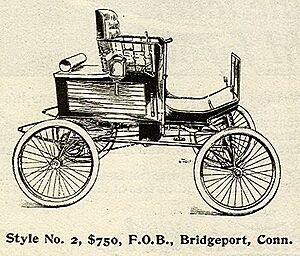
This American company bought the patents from the Stanley brothers. They built their steam buggies from 1898 to 1905. The Locomobile Company of America later started making gasoline cars and stayed in business until the Great Depression.
Stanley Motor Carriage Company
In 1902, twin brothers Francis E. Stanley and Freelan O. Stanley started the Stanley Motor Carriage Company. They made famous models like the 1906 Stanley Rocket, the 1908 Stanley K Raceabout, and the 1923 Stanley Steam Car.
Steam Cars in the 1900s
In 1906, a Stanley steam car, driven by Fred Marriott, broke the land speed record. It reached 127 mph (204 km/h) at Ormond Beach, Florida. This yearly "Speed Week" was the start of today's Daytona 500 race. No other land vehicle beat this record until 1910. It remained the world speed record for steam-powered vehicles until August 25, 2009.
Doble Steam Car
People tried to bring more advanced steam cars to the market. The Doble Steam Car was one of the most amazing. It started much faster because it had a very efficient steam generator that heated a smaller amount of water. It also had automatic controls for the burner and water. By 1923, Doble's steam cars could start from cold with a key turn and drive off in 40 seconds or less.
Paxton Phoenix Steam Car
Abner Doble also developed the Doble Ultimax engine for the Paxton Phoenix steam car. This car was built by the Paxton Engineering Division of McCulloch Motors Corporation in Los Angeles. It could produce 120 horsepower. However, the project was eventually stopped in 1954.
Why Steam Cars Declined
Steam cars became less popular after the electric starter was invented. This meant gasoline cars no longer needed risky hand cranking to start. Also, Henry Ford started mass-producing cars on assembly lines. This made gasoline cars like the Model T very cheap and reliable. This was a big reason why steam cars disappeared from the market.
Steam Cars in the Late 1900s
New Interest in Steam
In 1968, there was new interest in steam cars, partly because of new technologies. Some designs used safer and more responsive boilers. Charles J. and Calvin E. Williams built a prototype car. Other high-performance steam cars were built by Richard J. Smith and A.M. and E. Pritchard. Companies like Controlled Steam Dynamics, General Motors, Thermo-Electron Corp., and Kinetics Inc. all built high-performance steam engines around this time. Bill Lear also worked on a closed-circuit steam turbine for cars and buses. He built a transit bus and changed a Chevrolet Monte Carlo car to use this turbine system.
In 1970, Wallace L. Minto made a different kind of steam car. It used a special liquid called Ucon U-113 instead of water. This car was called the Minto car.
Breaking the Land Speed Record Again
On August 25, 2009, a team of British engineers ran their steam-powered car called "Inspiration" at Edwards Air Force Base in the Mojave Desert. It averaged 139.84 mph (225.05 km/h) over two runs. The car was 7.62 meters (25 feet) long and weighed 3,000 kg (6,600 pounds). It was built from carbon fiber and aluminium and had 12 boilers with over 2 miles (3.2 km) of steam tubing.
Images for kids
See also
- History of the automobile
- List of motorized trikes
- List of steam car makers
- Steam car
- Steam bus
- Steam engine
- Steam wagon
- The Steam House (Jules Verne novel)
- Timeline of motor vehicle brands





